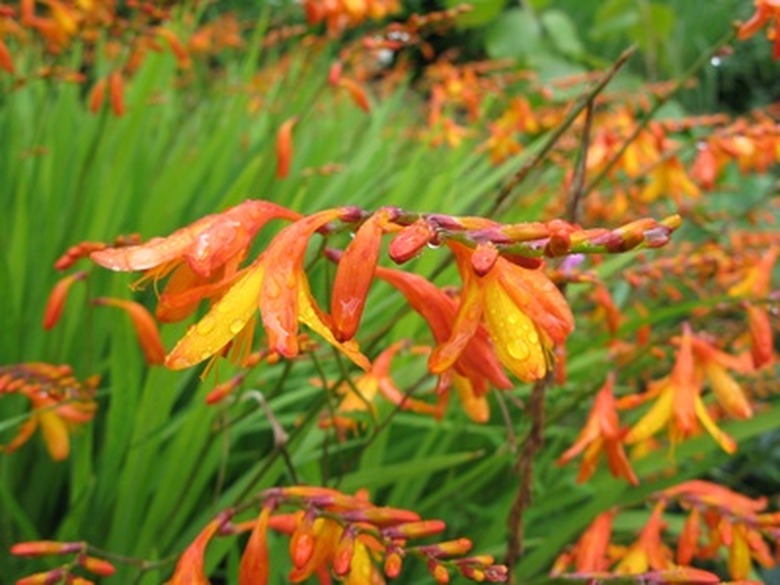About Crocosmia Flower Seeds
Crocosmias are a prolific summer bloomer, lending eye-catching appeal to the perennial border. Crocosmias are of the family Iridaceae and are commonly called coppertips and flying stars. Native to South Africa, crocosmia enjoys full sun in rich garden soil. The flowers come in reds, oranges, yellow and mixtures of the three colors. The plants are borne on 2- to 4-foot-tall thin stems which emerge as corms. They are often thought of as bulb flowers, but in reality they are planted from the corms or by seed.
Seed vs. Corms
There are approximately 400 cultivars of this genus, many of which spread invasively. Crocosmia can be allowed to reseed itself if it is an established planting. The only problem with this is the spreading habit, but it is perfect if you want to cover an area with beautiful flowers and appealing foliage. New plantings can be started either by seed or corms. Seed can be difficult to germinate and the gardener needs to be patient and wait for corms to form before the plants are ready to transplant. Some variation can occur when starting from seed, and the plants may not be as healthy as those from corms. There is no guarantee the grower will get a "true" variety, but something interesting may grow.
- Crocosmias are a prolific summer bloomer, lending eye-catching appeal to the perennial border.
- Some variation can occur when starting from seed, and the plants may not be as healthy as those from corms.
Features
Crocosmia develops from corms, which are different from bulbs in that they have no storage rings when cut in half. The corm is simply swollen stem tissue that acts as a storage base. The seeds will develop where the flowers were in pods. These will disperse where the plant grows or can be harvested to start another grouping in another location. Simply collect the pods after the tops have dried and cracked. The seeds will shake out of the pods and can be collected and stored for planting immediately or in the next season.
Planting Considerations
Crocosmia is a sun lover but needs well-drained soil with slight acidity. Purchased seeds will do best if started indoors, to allow them to develop corms. Seed-starter mix is adequate for germination, but if moving seedlings to larger pots some sand can be added to the potting mix to increase drainage. Seed should be started around February so the plants have time to grow and develop at least four sets of true leaves before they are transplanted.
- Crocosmia develops from corms, which are different from bulbs in that they have no storage rings when cut in half.
- Seed-starter mix is adequate for germination, but if moving seedlings to larger pots some sand can be added to the potting mix to increase drainage.
Starting Crocosmia by Seed
Starting crocosmia from seed is easy. Simply plant in seed trays 1/4 inch deep in a good starter mix and mist well. Keep the trays in a warm location (at least 60 degrees Fahrenheit). Crocosmia can take long to germinate: three to nine weeks. Keep well-watered until germination is achieved and plant outdoors in late spring 6 to 8 inches apart at a depth of 3 to 5 inches. Seedlings are delicate and do well with a little transplant fertilizer well-diluted in the first few waterings.
Older Crocosmia
Due to the invasive nature of some crocosmia, the corms may have to be thinned and dug out to prevent a garden takeover. Older patches of crocosmia should be dug up every three to four years and divided, then replanted. This will ensure bigger, brighter blooms the following season. Additionally, since the plants have seeded by fall, the old plants can be completely removed, allowing the new seedlings to take over. It may take a few seasons for the new baby plants to flower.
- Starting crocosmia from seed is easy.
- Due to the invasive nature of some crocosmia, the corms may have to be thinned and dug out to prevent a garden takeover.
Benefits
Crocosmias are almost unaffected by garden pests. Even slugs are not tempted to snack on their leaves. Butterflies and hummingbirds are extremely attracted to the colors and nectar. Cut crocosmias last a long time in a vase.
